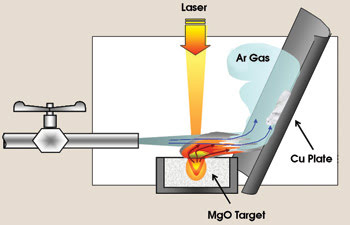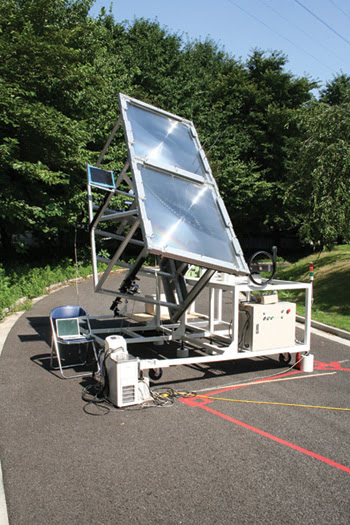
Can Lasers Help Decrease Our Dependence on Fossil Fuels?
Proposal envisions solar-powered laser as a key element.
Breck Hitz
It has been estimated that the solar power impinging on Earth in a single hour could satisfy mankind’s energy needs for more than a year. Nonetheless, solar energy today provides less than 0.1 percent of the world’s electric power and, according to the US Energy Information Administration, that percentage is not expected to increase significantly in the next quarter century.

Figure 1. A solar-pumped laser drives the magnesium-based cycle, which produces hydrogen gas as its product. The hydrogen can be used in fuel cells or, alternatively, can be burned directly to drive a turbine.
The reasons are both economic and practical. On the practical side, one drawback of solar power is that it is available only in daytime. Over the years, researchers have experimented with many techniques for storing solar energy, from batteries to molten salts, but none has proved efficient or economical enough to warrant widespread implementation.
Recently, scientists at Tokyo Institute of Technology and at Osaka University, both in Japan, proposed an approach using a solar-powered laser to drive a magnesium-based cycle that generates hydrogen gas as its product, as described in the Dec. 25 issue of Applied Physics Letters. Either the elemental magnesium that is generated by the cycle or the hydrogen gas itself can be stored until needed.

Figure 2. A laser heated the MgO to 4000 K, sufficient to separate it into its constituent elements. A steady flow of argon gas directed the vapor-phase magnesium to a copper plate, where it condensed. Reprinted with permission of Applied Physics Letters.
The laser acts to concentrate the intensity of sunlight so that it is capable of temperatures high enough to reduce MgO to its constituent elements (Figure 1). The magnesium subsequently reacts with water to produce hydrogen gas, which can be used in fuel cells or burned to produce energy.
The scientists have demonstrated several aspects of the cycle, including the laser-induced reduction of MgO. They heated the MgO to temperatures above 4000 K with a laser and allowed the gaseous Mg to condense on a copper plate (Figure 2). To suppress reoxidation in atmospheric air, they injected an argon-gas flow to guide the Mg to the condensation plate.
The solar-powered laser is a key component of the whole system. One possibility is a diode-pumped laser whose diodes are powered by solar cells; however, the scientists chose to demonstrate a directly solar-pumped Nd:YAG laser. Theirs is not the first to utilize sunlight to optically pump an Nd:YAG laser, but their laser does manifest several significant advances over previous ones.
They co-doped their laser with chromium to increase its absorption of sunlight and used ceramic YAG to obtain higher doping levels than would be possible with crystalline YAG. They arranged two YAG rods in an oscillator-amplifier configuration, each rod pumped by a separate Fresnel lens solar collector (Figure 3).

Figure 3. A pair of Fresnel lenses (total area ~1.3 m2) collected sunlight to pump the ceramic Cr:Nd:YAG oscillator amplifier. The entire assembly rotated to track the sun across the sky. Reprinted with permission of Applied Physics Letters.
They believe that all previous solar-pumped lasers depended on parabolic mirrors or heliostats to collect sunlight. With the Fresnel lenses, they obtained 24.4 W of output from the laser, from a solar-collecting area of 1.3 m2. This is nearly three times the best collector-to-laser-power ratio achieved with previous lasers.
But the investigators believe that much greater efficiencies are possible. Their Fresnel lenses were designed for image projection, not solar collection, and focused less than 70 percent of the incident sunlight onto the focal point. They expect much better efficiency from Fresnel lenses designed for solar collection, which recently have been constructed and currently are being integrated into the system.
The slope efficiency of the solar-pumped laser was 14 percent, although the absolute efficiency was only 2.9 percent because the laser was operating only slightly above its threshold. However, when they implement an improved Fresnel lens to boost the pump power from ∼900 W to ∼4 kW, the researchers expect that the laser will be far above threshold and that its absolute efficiency will approach the 14 percent slope efficiency.
For a solar power station, the scientists envision tens of thousands of kilowatt-class solar-pumped lasers reducing MgO and generating hydrogen, as illustrated in Figure 1. Of course, the ultimate question for any solar energy scheme is the economic one, but the researchers believe that it is far too early to make a meaningful estimation of the economies of scale that may be possible with their magnesium-cycling concept
Applied Physics Letters, June 25, 2007, 261120.
Published: September 2007